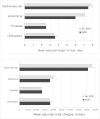Sleep-disordered breathing and postoperative outcomes after elective surgery: analysis of the nationwide inpatient sample
- PMID: 23538745
- PMCID: PMC3760743
- DOI: 10.1378/chest.12-2905
Sleep-disordered breathing and postoperative outcomes after elective surgery: analysis of the nationwide inpatient sample
Abstract
Background: Systematic screening and treatment of sleep-disordered breathing (SDB) or obstructive sleep apnea (OSA) in presurgical patients would impose a significant cost burden; therefore, it is important to understand whether SDB is associated with worse postoperative outcomes. We sought to determine the impact of SDB on postoperative outcomes in patients undergoing four specific categories of elective surgery (orthopedic, prostate, abdominal, and cardiovascular). The primary outcomes were in-hospital death, total charges, and length of stay (LOS). Two secondary outcomes of interest were respiratory and cardiac complications.
Methods: Data were obtained from the Nationwide Inpatient Sample database. Regression models were fitted to assess the independent association between SDB and the outcomes of interest.
Results: The cohort included 1,058,710 hospitalized adult patients undergoing elective surgeries between 2004 and 2008. SDB was independently associated with decreased mortality in the orthopedic (OR, 0.65; 95% CI, 0.45-0.95; P = .03), abdominal (OR, 0.38; 95% CI, 0.22-0.65; P = .001), and cardiovascular surgery groups (OR, 0.54; 95% CI, 0.40-0.73; P < .001) but had no impact on mortality in the prostate surgery group. SDB was independently associated with a small, but statistically significant increase in estimated mean LOS by 0.14 days (P < .001) and estimated mean total charges by $860 (P < .001) in the orthopedic surgery group but was not associated with increased LOS or total charges in the prostate surgery group. In the abdominal and cardiovascular surgery groups, SDB was associated with a significant decrease in adjusted mean LOS of 1.1 days and 0.35 days, respectively (P < .001 for both groups), and adjusted mean total charges of $3,814 and $4,592, respectively (P < .001 for both groups). SDB was independently associated with a significantly increased OR for emergent intubation and mechanical ventilation, noninvasive ventilation, and atrial fibrillation in all four surgical categories. Emergent intubation occurred significantly earlier in the postoperative course in patients with SDB. In the subgroup of patients requiring emergent intubation, LOS, total charges, pneumonias, and in-hospital death were significantly higher in those without SDB.
Conclusions: In this large national study, despite the increased independent association of SDB with postoperative cardiopulmonary complications, the diagnosis of SDB was not independently associated with an increased rate of in-hospital death. SDB had a mixed impact on LOS and total charges by surgical category.
Figures




Comment in
-
Sleep-disordered breathing and postoperative outcomes: patient safety first!Chest. 2013 Oct;144(4):1421-1422. doi: 10.1378/chest.13-1342. Chest. 2013. PMID: 24081363 No abstract available.
-
Response.Chest. 2013 Oct;144(4):1422. doi: 10.1378/chest.13-1752. Chest. 2013. PMID: 24081364 No abstract available.
References
-
- Chung F, Yegneswaran B, Liao P, et al. STOP questionnaire: a tool to screen patients for obstructive sleep apnea. Anesthesiology. 2008;108(5):812-821 - PubMed
-
- Gupta RM, Parvizi J, Hanssen AD, Gay PC. Postoperative complications in patients with obstructive sleep apnea syndrome undergoing hip or knee replacement: a case-control study. Mayo Clin Proc. 2001;76(9):897-905 - PubMed
-
- Kaw R, Chung F, Pasupuleti V, Mehta J, Gay PC, Hernandez AV. Meta-analysis of the association between obstructive sleep apnoea and postoperative outcome. Br J Anaesth. 2012;109(6):897-906 - PubMed
-
- Kaw R, Pasupuleti V, Walker E, Ramaswamy A, Foldvary-Schafer N. Postoperative complications in patients with obstructive sleep apnea. Chest. 2012;141(2):436-441 - PubMed
-
- Mador MJ, Goplani S, Gottumukkala VA, El-Solh AA, Akashdeep K, Khadka G, Abo-Khamis M. Postoperative complications in obstructive sleep apnea. Sleep Breath. 2012;17(2):727-734 - PubMed
Publication types
MeSH terms
Grants and funding
LinkOut - more resources
Full Text Sources
Other Literature Sources
Medical

